27 May 2003, Al Hillah, Iraq. Engineering Aide 1st Class Scott Lyerla, of Navy Mobile Construction Battalion 15, mans a MK43 Mod 0 machine gun to provide security for his convoy conducting a road movement during Operation Iraqi Freedom. (US Navy photo by PHM1C Arlo Abrahamson)
By Robert Bruce
“The M60E4 is a great weapon and definitely fills the gap between vehicle mounted M240B and dismounted M249 SAW. Scout teams have been taking them out to overwatch and support the snipers, occupying OPs near them and carrying the M60E4 because it is small enough to hump a good distance and has great firepower. Some comments directly from soldiers: The M60E4 is small enough to maneuver in tight places, it allows for easy access entering and exiting vehicles and aircraft, can be shoulder fired in short bursts accurately, does not require a complete crew to operate effectively.” Email to US Ordnance from an officer of 101st Airborne Division in Operation Iraqi Freedom
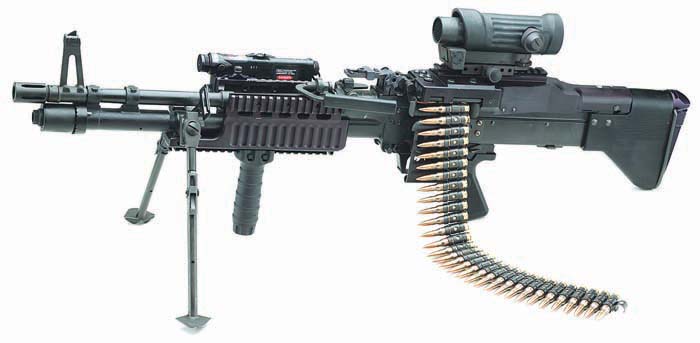
What’s not to like about a real machine gun that’s significantly lighter than a chunky M240, about the same size as a puny SAW, pumps out powerful 7.62mm rounds with reliability and accuracy, and has long been a force multiplier in elite Navy SEAL Teams? GIs who’ve tried ‘em love ‘em, they’re comparable in price to buy and sustain as the FN guns, they’ve been in the logistics and combat doctrine chains for ever, and they’re 100 percent American designed and built. Slam dunk? Sorry.
The “Screaming Eagles” in Iraq only had a few of the newest Sixties, provided free of charge by US Ordnance in response to their urgent request while forward deployed for the Global War on Terror. US Ord sent a crate full of MK43s (M60E4), spare barrels and spare parts to Fort Campbell and the Army delivered it to Iraq.
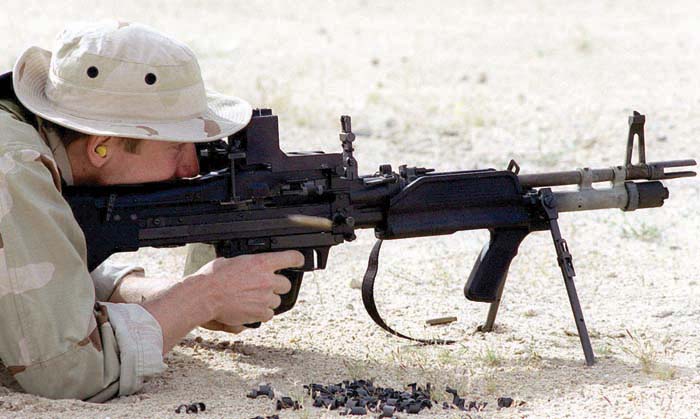

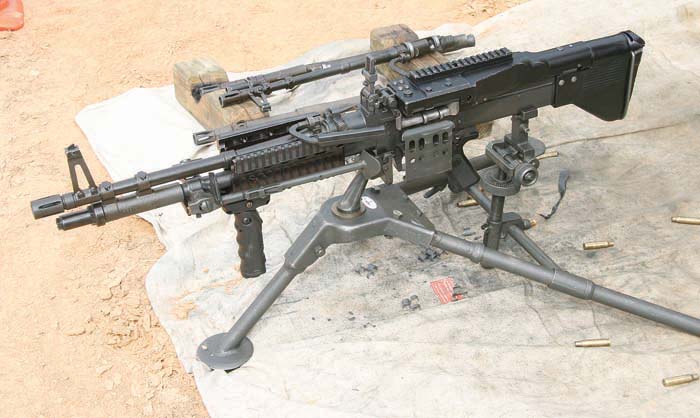

Subsequent use in the unforgiving arena of intense urban combat resulted in a number of enthusiastic responses leaking out, but any formalized after action report has apparently been kept on close hold. We are unaware of any plans by the Army for further evaluation and PM Soldier Weapons is moving out at double time to develop a lighter and shorter version of the M240.
Meanwhile, production of M240s and 249s at FN’s South Carolina plant continues at breakneck pace but there remains a substantial backlog. This necessitates keeping large numbers of existing M60s in service with all branches of the US Armed Forces. But these guns are mostly old and tired veterans of decades of hard service and victims of poor maintenance with shoddy and cannibalized parts. What’s going on here?
Life and Times of the M60
Developed in the aftermath of WWII and fielded in 1957, the light and handy 7.62mm NATO caliber M60 General Purpose Machine Gun (GPMG) has been alternately praised and cursed by GIs who have carried it combat from Vietnam to Iraq and beyond.
Inspired by the WWII German MG42, the M60 was intentionally designed for mass production – cheap and fast on a stamped sheet metal receiver that houses a clever gas operated, carrier-cammed bolt mechanism first seen in the Lewis Gun of WWI. It replaced the Browning-designed M1919 series, built on heavy riveted steel receivers with lots of machining required for its beefy, recoil operated internals.
When the original M60 is good, it is very good; appreciated for its compact size, good handling, mechanical simplicity, quick change barrel, and effective operation from shoulder, hip, bipod, tripod, or vehicle/watercraft/aircraft mounting.
But when it’s bad it deserves its ‘Nam nickname “The Pig.” Punishing combat use in Vietnam’s tropical climate was hard on men and unforgiving of their weapons, adversely affecting all US arms which had been designed primarily for land warfare in Europe. The M60 was lightweight, but correspondingly flimsy, prone to damage and relatively quick to wear out critical parts like the bolt and op rod.
Special emphasis on parts is called for here. With spares and replacements supplied in later decades by unevenly performing, lowest-bid subcontractors, the gun itself can’t be blamed for problems arising mostly from user abuse, poor maintenance and extreme environmental conditions.
Despite its handicaps, the Sixty performed rather well when light weight and mechanical simplicity were preferred vs. the heavy M1919 series .30 caliber guns. Determined to phase out all those old Brownings, the Army began a series of modifications to the basic M60. The M60D came first, a helicopter door gun characterized by its spade grips and prominent ring sight. The solenoid-fired M60E2 was developed about the same time, a coaxial gun for tanks and helo gunships.
The M60E3 followed, dropping five pounds in a major overhaul demanded by the Marine Corps. Easily recognized by pistol grips fore and aft and a receiver mounted bipod freed from the barrel, the weight loss unfortunately came with poor durability and reduced performance.
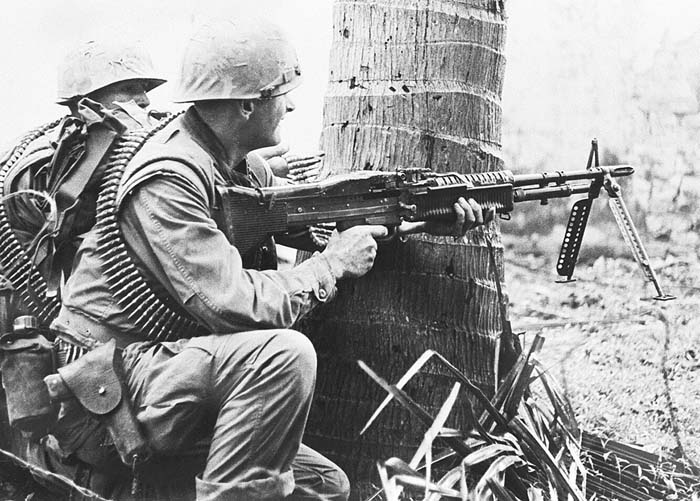
Over on the Navy side, SEALs liked their regular M60s, used since ‘Nam with sawed-off barrels and no front sights. Some even utilized clever backpacks fitted with flexible feed chutes, capable of delivering a thousand rounds or more when things got particularly hairy. Yeah, the 5.56mm Stoner LMG and the M249 SAW had their place, but there’s no substitute for hard-hitting 7.62mm rounds. Unfortunately, the troubled E3 wasn’t up to the job.
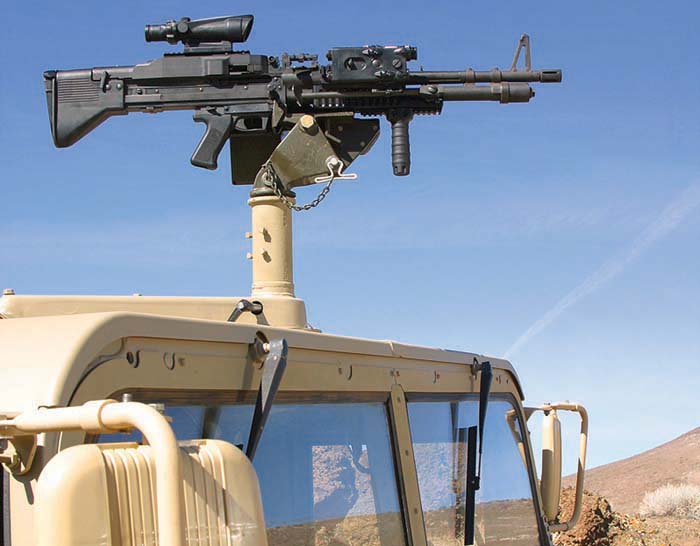
In the early 1990s, SACO responded to Navy Special Warfare’s unique requirements and specifications, developing a retrofit parts package they called M60E4. Quantity deliveries of new guns and E4 parts kits to SEALs and other NAVSPECWAR units began in late 1994, receiving the Navy designation MK43 Mod 0.
Still reasonably light but significantly more reliable and durable than the despised E3, SEAL Team MK43s can be recognized by a distinctive “duckbill” flash suppressor and a positive lock gas cylinder extension that is stubbier and thicker.
SAWing Off The Sixty
Over on the Army side, the 5.56mm M249 Squad Automatic Weapon began taking the automatic rifle’s place in regular infantry units in the mid-1980s. This boost in firepower resulted in official Army doctrine being modified to reduce the number of M60s used in the traditional role of “General Purpose Machine Gun” in most infantry formations. On the other hand, vehicle and aircraft 60s were unaffected by this ruling and continued soldiering on.
While there have been and continue to be fierce debates about the wisdom of all aspects of this, Infantry Board documentation from the period asserts that the Belgian- designed mini machine gun would make up for lack of reach and penetration with one-man portability and high volume of fire.
It is no exaggeration to say that this radical change wasn’t warmly received by all members of the infantry community.
Yes, bootborne movement to contact in offensive operations is faster with the lighter SAW, but once the firefight begins there is little to recommend using anything smaller than 7.62mm. Same deal in defensive operations where bipod and tripodmounted Sixties have significantly superior accuracy at longer range and decidedly deadlier terminal effect than the M249.
At the same time, users of multitudes of aging M60s in tanks, helos and other tactical platforms were developing serious envy for their counterparts in the US Marine Corps. Leathernecks were beginning to get another Belgian designed weapon, the 7.62mm M240, marveling at its astonishing reliability and durability.
Against this background, sufficient pressure was brought to bear in favor of retaining a 7.62mm belt fed weapon for infantry combat. But the burning question was which medium machine gun would be best?
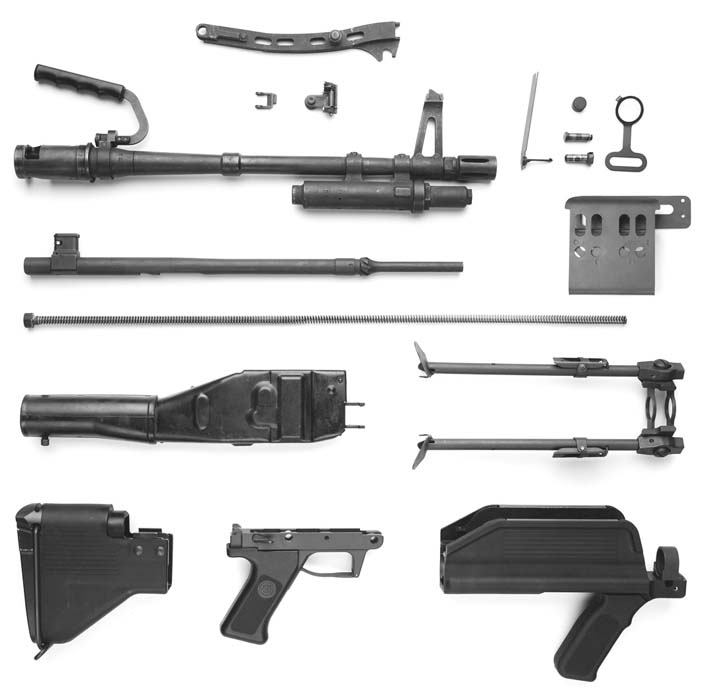
The process of finding an answer began with Fort Benning’s Dismounted Battlespace Battle Lab (DBBL, commonly pronounced “dibble”) preparing a detailed list of what the ideal weapon would have to do. This drove specific requirements for technical testing at Aberdeen Proving Ground and more general operational testing at Fort Campbell.
Trial by Fire: Sixty vs. 240
The Army’s big 7.62 belt fed shootout kicked off in January 1994 under the interesting program title of Medium Machine Gun Upgrade Kit. This name actually fits rather well because the only two significant competitors – M60s and M240s – were modified versions of weapons currently in the Army inventory.
SACO’s “Enhanced” M60E3 guns were fitted with a number of product improved parts and the FN 240s were coaxial guns from M1 Abrams tanks, converted for dismounted ground combat with buttstocks, bipods and such; hence the “Upgrade Kit” moniker for both.
Each manufacturer submitted eighteen guns and more than a year of technical torture and tactical trials ensued. This ended in December 1995 when the Army declared the M240 victorious.
Not surprisingly, there were strong critics of the decision then and now, raising objections and citing shortcomings in the process with varying degrees of credibility. Sadly, by keeping a close hold on details of the test regimen and tabulated results, the Army hasn’t helped dispel inevitable misinformation.
What is a matter of public record is the much-cited test results table quantifying two key performance areas; Mean Rounds Between Stoppages (MRBS) and Mean Rounds Between Failures (MRBF). Stoppages are jams and failures are parts breaking – both are essential indicators of combat serviceability.
50,000 rounds were fired through both the M60 and the M240. The 240 was a runaway winner in averaging 2,962 MRBS and 6,442 MRBF. The Sixty limped along at 846 MRBS and 1,669 MRBF.
Determined to find and report more facts of the matter, SAR went right to source, Program Manager Soldier Weapons at Picatinny Arsenal. Naturally, our first request was for hard copy of test documentation.
Sorry, came the official answer, “We can’t release any test paperwork until SAR’s request goes through legal.” Seems the specter of defamation lawsuits still looms darkly even after a dozen years have past and even where tabulated test results speak for themselves.
OK, we pressed, how about an interview with Ed Malatesta, the individual who was Product Director/Program Manager for the process? Although since retired from government service, as luck would have it he’s now an independent contractor working at PMSW. A phone interview was agreed to and arranged by officials in surprisingly short order.
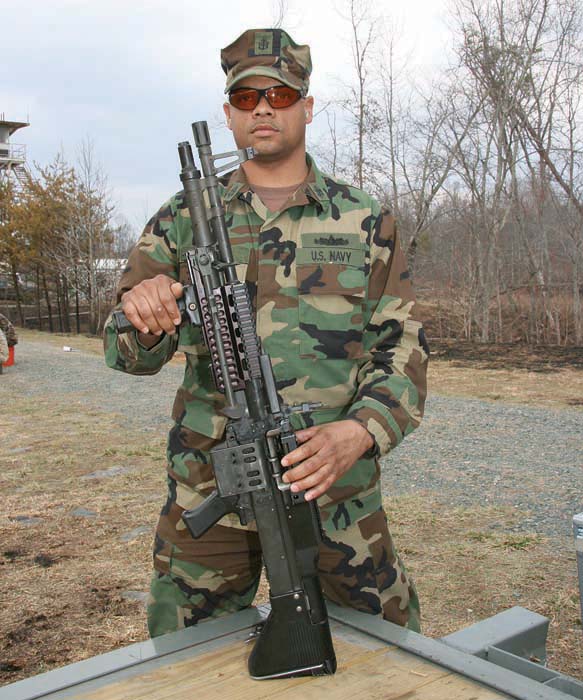
In a conference call and subsequent email exchange Malatesta was very emphatic on the following:
SAR: What major factor(s), in your opinion, led to the decision to phase out the M60 in favor of the M240?
Malatesta: Reliability was by far the major factor. The M60s were always breaking and this doomed them almost from the beginning.
SAR: How is this shown in program documentation?
Malatesta: In data reporting the various test results. Based on this, the Army Source Selection Authority, a general officer, wrote in summary, “In view of the above discussions (Reliability, Probability of Hit, Human Factors and Price) and based on an integrated assessment of the above findings (Developmental Tests, Operational Tests, Human Engineering Testing and a Price Assessment), I conclude that Saco (M60) has no reasonable chance for award and should be eliminated from the competitive range, and that a competitive range of one, Fabrique Nationale Manufacturing, Inc. (M240) be established.”
SAR’s candid discussion with Malatesta, coupled with additional research, clearly shows the fundamental problem that, in his words, “doomed” the Sixty. Put aside all the “Enhanced” M60E3’s niceties of lighter weight, portability, balance, controllability in assault fire, easy to parachute with, already in the inventory, tons of spare parts, existing instructional materials, lots of experienced armorers, etc., etc.: SACO’s Sixties broke down way too often while FN’s 240s didn’t.
And the Army moved out smartly to fully equip the force with a new machine gun that – despite being considerably heavier – was vastly more reliable. When you need it to shoot, it shoots.Passing a Sputtering Torch
Prior to its last-ditch effort in the “Upgrade Kit” trials, M60 production had long been the exclusive domain of Saco Defense, where a skilled force of dedicated craftsmen had been turning out hundreds of thousands of these guns in various configurations. But for some reason the level of quality seems to have dropped.
This is particularly puzzling given Navy Special Warfare’s apparent satisfaction with their measurably improved M60E4/ MK43s of about the same time frame.
It must be left to others to explain the reasons for the abysmal performance of the eighteen guns SACO brought to the Army’s gunfight in 1994. SAR’s numerous phone calls – with detailed messages left for a certain individual who had been identified to us as a key player on the industry side of the trials – were not returned.
Market forces being what they are, SACO was acquired by defense industry giant General Dynamics in 2000. No secret that the Sixty was by then a neglected stepchild as Big Army transitioned to the M240 and it would have slowly faded away if it weren’t for a visionary named Curtis Debord.
We contacted Steve Helzer, General Manager of US Ordnance, Inc., located in Reno, Nevada, to get the straight story on how the M60 was saved from a lingering but certain death. What follows is based on telephone conversations and email exchanges.
SAR: Who is primarily responsible for acquiring the M60 rights from SACO and what was his reason for pursuing this?
Helzer: In 2000, Curtis Debord recognized that there was a business opportunity for a small arms manufacturer in acquiring the original tooling, technical data packages, processes, and procedures necessary to make a MIL-SPEC M60. General Dynamics (GD) was just completing the purchase of SACO Defense and recognized that they had an obligation to ensure the availability of spare parts for the M60 for the next five to ten years. But GD wanted out of the 7.62mm General Purpose Machine Gun business so a licensing agreement between US Ordnance and Saco Defense/GD was a logical conclusion. It ensured the availability of spare parts and ensured that the M60 remained in production. Spare parts and complete weapon systems would be available, and design improvement work could continue.
SAR: We have seen plenty of evidence to convince us that US Ordnance’s M60E4 – initially fielded by Navy Special Warfare as the MK43 Mod 0 and now the Mod 1 – represent significant ‘design improvements’ over all previous versions. Will you take our readers through its mechanical upgrades?
Helzer: US Ordnance’s MK43s feature twenty-two key improvements. I’ll list them roughly from muzzle to buttstock, not necessarily in order of importance —
- Redesigned flash suppressor. It’s shorter, more effective and not prone to breaking like the ‘duck bill’ variant used in early SEAL team guns.
- Adjustable front sight allows for zeroing of spare and primary barrel prior to mission operation. The old design required the gunner during combat to remember to adjust the rear sight for each barrel change. A small relief cut in the new front sight base decreases the chance of losing the front sight in the field.
- Bipod moved from barrel to receiver. This has reduced the weight of the spare barrel and keeps the receiver stable, off the ground away from debris and pointed down range during barrel changes.
- Bipod is strengthened and simplified, one hand operated and has ambidextrous legs to ease maintenance and spares.
- Improved forward handguard with increased heat shielding that protects the operator from barrel heat, plus a forward pistol grip for better control.
- Mod 1 variant has a Rail Interface Handguard with removable/repositionable pistol grip. This accommodates different sized soldiers and allows mounting of the gun to most all existing platforms. Three rails (both sides and underneath) allow mounting of multiple items like lasers and aiming devices.
- Carry handle is mounted on the barrel to facilitate hot barrel change and offset so it won’t get in the way of the sights.
- Improved gas system is “soldier proof” reversible. The old system was one direction only and if assembled wrong the gun would fire once and not cycle.
- Gas tube on the barrel is simplified with three fewer parts than the old standard.
- Both the Mod 0 and Mod 1 come with an aluminum rail top cover to facilitate the mounting of optics.
- A new spring loaded feed cam allows loading of the weapon with the bolt forward (safe position) or rearward (charged) without damaging the feed cam assembly.
- A redesigned feed cam, feed pawl assembly, and cartridge retaining pawl for 30% improved belt pull to overcome misaligned ammo and debris.
- Two sear notches on the operating rod help prevent run away gun in extreme operating environments.
- The operating rod tube is now hard chrome plated for corrosion resistance and to facilitate cleaning. Its fore end is induction hardened to resist mechanical wear from the forward sling mount.
- A new captured pin prevents accidental detachment and loss of the trigger group.
- Improved trigger grip housing that is stronger and redesigned to prevent trigger pin from being installed backwards in unsafe position.
- Ambidextrous safety.
- A trigger guard that hinges down to allow trigger finger access wearing thick winter mitts or NBC protective gloves.
- Nyloc safety nut on cocking handle retainer holds tight despite vibration and allows for multiple assembly and disassembly with no degradation.
- The ammunition hanger is now rigidly mounted to the side of the receiver – unlike the previous version, where the hanger was mounted to the feed try. Now, when checking the chamber, the gunner doesn’t have to lift a belt of heavy ammunition and also risk dumping it out of the bandoleer.
- Improved polymer buttstock that is lighter and stronger while retaining the hinged shoulder rest feature.
- Overall weapon length (fitted with short barrel) is 5 inches shorter then the Standard M60 and almost 4 pounds lighter
SAR: When we interviewed Dale McClellan at STS he said there were some other improvements in the works. (Editor’s Note: SAR’s interview with McClellan, a former SEAL M60 gunner and now president of STS, is a fascinating perspective on development of the MK43 Mod 1 and slow death of the Sixty in the US Navy. It is scheduled to run in an upcoming issue)
Helzer: That’s right. Our improved short fluted barrel is currently available and is based on the ones that STS did the 850 round demos with. Still in the RDT&E (research, development, test and engineering) stages are the improved cocking handle, bolt with new metallurgy, and a modification to the feed tray. We’re always working to improve our M60 family of guns and there are a couple of other things that maybe we can talk about in a few months.
SAR: What US military/government/law enforcement entities have purchased at least several guns and/or quantity orders for spares in the last couple of years?
Helzer: We have sold to numerous Sheriff Departments to assist with their new role in Homeland Security. Primarily for Maritime Security escort duty for tankers carrying oil or LNG (Liquefied Natural Gas) in states with ocean access ports. We would prefer not to mention their names as this might be somewhat sensitive. It is safe to say we have ongoing programs on both coasts and in with the gulf coast states to arm their various patrol boats with Mk43s.
The US Army Tank and Automotive Command in Rock Island, Illinois (TACOM-RI) is our largest customer. TACOM-RI purchases are primarily for Foreign Military Sales. We have also received US Government purchase orders for spare parts from TACOM-RI, Defense Supply Center Columbus (DSCC) and Defense Supply Center Philadelphia (DSCP) for use by our own soldiers. These have primarily been spare barrels and sub assemblies for complete weapons.
And, we just delivered a small quantity of complete MK43 Mod 1s to the US Navy.
SAR: What foreign countries have gotten guns in quantity over the last two years?
Helzer: Colombian Navy and Army, Czech Republic for their 601st Special Forces, Philippine Air Force, Spanish Air Force, Italian Navy, Chilean Air Force, and Thai Navy. The M60 family of weapons is still very popular around the free world.
SAR: What’s the price of the MK43 retrofit parts kit?
Helzer: Anyone with a serviceable M60 receiver can have what amounts to a brandnew MK43 for about 60 percent of the cost of a complete new gun. Or, we’ll be happy to sell them a complete MK43 Mod 1 for $11,200 (domestic suggested retail price). That’s less than commercial price for FN’s M240 and significantly less than their MK48 guns. Our MK43s are in stock and ready for delivery to US Government and law enforcement pending ATF transfer approval.
SAR: We know that US Ord used to sell semiauto M60s that were civilian legal with no special paperwork. But now, the website says resumption of sales is delayed indefinitely. Comment?
Helzer: The Global War on Terror has caused a dramatic impact on the small arms industry. As our government orders ramped up we pulled our employees from the semi-auto production line and converted that area in our shop to military and law enforcement. This was a difficult decision because of the large and loyal civilian M60 following but a necessary one to support the warfighter and our coalition partners. Sales are still delayed indefinitely.
SAR: How many semiauto US Ord Sixties are out there now?
Helzer: There are more than 150 of the M60, M60E3 and a small number (10-20) of factory M60E4/Mk43 Mod 0 and Mod 1 semi autos in civilian hands.
Live Firing the MK43
The scope of this feature is not intended to include a hands-on evaluation of the new Sixties from US Ordnance. This has been well done by others, most notably Kent Lomont, the highly respected tactical small arms guru and SAR-certified “RKI.”
In a recent telephone conversation, Lomont told us he has put more than 70,000 rounds of “every kind of ammo” through his US Ord MK43 with excellent results. In no uncertain terms he declared, “It’s a goddamn good gun! For the first time there’s a Sixty you can bet your life on.”
Lomont’s salty and straightforward endorsement tracks with what we have repeatedly heard from law enforcement and military users. To the point, the MK43 has proven itself over recent years in hard training and combat operations by Navy SEALs and other elite formations such as the “Screaming Eagles” in Iraq.
We have personally observed the situation where one US Ordnance MK43 Mod 1 was run without incident for several thousand rounds in the industry demo and participant live fire opportunity at NDIA Small Arms 2006. Then, in our day on the range with students of Navy Center for Security Forces’ Crew Served Weapons Instructor Course, no problems occurred with either of two US Ord MK43 guns that were hard-used all afternoon by a dozen Sailors.
Those who are still skeptical are invited to see for themselves some real torture tests of the MK43. A couple different 850 round continuous burst videos are linked on the Special Tactical Services’ website at www.spectacserv.com. Click VIDEOS on the navigation bar, then select MACHINE GUNS. Plenty more folks have accessed and marveled the one at Blackwater that is posted on YouTube.
MK43 Mod 1 Technical Specifications
Source: US Ordnance Product Documentation
Caliber: 7.62 x 51mm NATO
Operation: Gas piston with 2-lug turning bolt
Weight: 20.5 pounds with short barrel
Length: 37 inches with short (16.5 in.) barrel
Barrel options: Short (16.5 in.), Assault (17.5 in.) and Long (21.5 in.)
Cyclic Rate: 500 to 600 rounds per minute
Max. effective range: 1100 meters
Notes: The latest product improvement of M60E4/MK43 is quickly recognized by Rail Interface System (RIS) forearm assembly with integrated Mil-Std 1913 rail system for mounting laser and lighting systems, plus improved control with a repositionable pistol grip. Also, one-piece milled aluminum feed tray cover with optional/integral RIS for mounting virtually any scope, night vision or electrooptic system. The Conversion Kit is available for all M60 variants that is 100% backwards compatible with all pre-existing M60’s. All components and parts of the MK43 Mod 1 are built to exceed original mil-spec standards.
Find Out More
US Ordnance, Inc.: www.usord.com
Special Tactical Services, LLC:
www.spectacserv.com
Link to 850 round demonstration video:
www.youtube.com/watch?v=mBNGguOqGIQ
| This article first appeared in Small Arms Review V11N7 (April 2008) |











